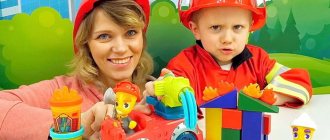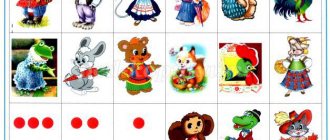Program "Algorithms for preschoolers"
The subject-development environment corresponds to the interests and needs of children, the goals and objectives of the additional general education program.
Requirements for an additional education teacher implementing the program
.
A teacher of additional education must know: priority directions for the development of the educational system of the Russian Federation; laws and other regulatory legal acts regulating educational activities; Convention on the Rights of the Child; developmental and special pedagogy and psychology; physiology, hygiene; the specifics of the development of interests and needs of students, pupils, the basis of their creative activity; methods of searching and supporting young talents; content of the curriculum, methodology and organization of additional education for children in health, sports, and leisure activities; training programs for clubs, sections, studios, club associations; activities of children's groups, organizations and associations; modern pedagogical technologies for productive, differentiated, developmental education, implementation of a competency-based approach; methods of persuasion, argumentation of one’s position, establishing contact with students, pupils, children of different ages, their parents, persons replacing them, work colleagues; technologies for diagnosing the causes of conflict situations, their prevention and resolution; technologies of pedagogical diagnostics; basics of working with a personal computer (word processors, spreadsheets), email and browsers, multimedia equipment; internal labor regulations of an educational institution; labor protection and fire safety rules.
Qualification Requirements
.
Higher vocational education or secondary vocational education in a field corresponding to the profile of a circle, section, studio, club or other children's association without presenting work experience requirements, or higher vocational education or secondary vocational education and additional vocational education in the direction of "Education and Pedagogy" without presenting work experience requirements. Organization of a developing subject-spatial environment.
The subject-spatial environment of a preschool institution provides:
— maximum realization of the educational potential of the organization space and materials, equipment and inventory for the development of preschool children;
— the opportunity for communication and joint activities between children and adults;
— provides playful, educational, research and creative activity for all categories of pupils. Experimenting with materials available to children;
MAGAZINE Preschooler.RF
Summary of the manual for a role-playing game on the topic: “Hospital” for children 3-4 years oldCompiled and conducted by teacher Burmistrova M.S. Volodarsky village 2019 DEPARTMENT OF EDUCATION OF THE ADMINISTRATION OF LENINSKY MUNICIPAL DISTRICT MUNICIPAL AUTONOMOUS PRESCHOOL EDUCATIONAL INSTITUTION "KINDERGARTEN No. 14 "YAGODKA"
Goal: to expand children’s understanding of the work of hospital workers; to develop in children the ability to apply previously acquired knowledge about life around them in play.
Tasks:
- Teach children to interact in stories with two characters (doctor, patient)
- Teach children to show interest in the playful activities of their peers
- Lead children to understand their role in the game
- Develop the ability to choose a role, perform several interrelated actions while playing with toys (give injections to Katya’s doll, perform procedures, write prescriptions)
- To develop children’s interest in role-playing games, to develop the ability to accompany their actions with verbal notations
- Develop the ability to interact and get along with each other
a short game together.
- Foster friendly relationships between children.
Material and equipment:
Children's set "Hospital" (thermometer, syringe, phonendoscope, bandage, cotton wool), chairs for patients, gowns and caps for doctors and nurses, dolls, leaves and pens, empty medicine boxes.
Preliminary work:
Conversation on the topic “Hospital”
Examination of illustrations, familiarization with medical instruments (syringe, cotton wool, thermometer, bandage).
Reading fiction by K. Chukovsky “Aibolit, V. Suteev “About the hippopotamus who was afraid of vaccinations .
Game roles:
Doctor, nurse, patients.
Progress of the game:
Children enter the group and stand around the teacher.
Educator: guys, today guests came to our group, let’s say hello to them.
Children: Hello!
Children sit on chairs.
V.: There are many different professions in the world, And people need all of them, From the simplest to the most important, They are all important in life.
For example, the profession of a doctor. How did people live in the world without her? Doctors are needed everywhere and always, so that children grow up healthy.
The doctor will carefully examine everyone and find out what hurts and where. Well, then he will make a diagnosis and only then begin to treat.
A doctor is always needed, needed everywhere,
To live peacefully on Earth
Q: Guys, if someone gets sick, adults or children, where do we turn?
D: To the hospital.
B: Yes, that's right. What is the job of a doctor?
D: Treat people.
Q: What kind of doctor should a doctor be?
D: Attentive, caring, kind.
Q: Well done, guys! Well, our time has come, let's play now! Do you want to play?
D: Yes!
Didactic game “Magic Bag”
Q: Guys, let’s play the game “What does the doctor need? To do this we will take our magic bag.
Children choose from the proposed items the ones the doctor needs and tell why, in their opinion, this or that item is needed).
Syringe - give an injection. Thermometer - measure temperature. Vata - lubricate wounds. Bandage - bandage a wound.
Q: Children, someone is crying in our corner. Oh, but this is a Katya doll. Now I’ll ask her what happened and I’ll tell you.
Q: Katya’s doll has a sore throat. She was walking outside, got her feet wet and caught a cold. We need to do something urgently. I came up with an idea!
Now I will put on a white coat and treat her. I will be a doctor. This is my hospital, my office. Here are the medicines
Thermometers, syringes for injections, bandages...
I also need an assistant - a nurse. She will write prescriptions and perform procedures. Who wants to help me?
(we select a nurse from the children according to the counting rhyme)
In the morning the butterfly woke up, smiled, stretched, once - she washed herself with dew, twice - she twirled gracefully,
Three - she bent down and sat down, And four - she flew away.
V.: You, Masha, will be a nurse, sit down with me here. Let's get started. (addresses the doll)
- Katyusha, let me examine you. Now I’ll take a phonendoscope and listen to you. Open your mouth - the neck is red. Now the nurse will write you a prescription: it’s cough syrup. And you will definitely get better.
Goodbye, Katyusha, no more pain!
V.: Guys, now let one of you be a doctor.
D: Let's go!
V.: We choose a doctor and a nurse among the guys according to a counting rhyme. (Example: doctor - Maxim, nurse - Ksyusha).
The teacher acts as an observer and, if necessary, helps correct the children’s play actions.
V.: Come to see the doctor. In order not to jostle and disturb each other, patients can sit on chairs and wait for their turn. Look how many patients are sitting on chairs and everyone is in pain, let's help them?
Independent play actions of children under the indirect guidance of a teacher:
Doctor: Hello, patient! Come in, sit down! Tell me exactly where your pain is concentrated?
Patient: Hello. I fell and my arm hurts.
Doctor: Let's see what's wrong with your hand. What a big wound, now we will treat it well, lubricate it with iodine, like this. Please go to the nurse, she will give you painkillers (inject with a syringe). Get well. Goodbye.
Patient: Hello.
Doctor: Hello. Come in, sit down. Tell me what happened?
Patient: My stomach hurts.
Doctor: Let’s see, listen to the patient: “Breathe, don’t breathe” (the doctor examines the patient). Nurse, prescribe pills for the patient.
Educator: All people are examined, vaccinated, and examined by a doctor. You see guys, doctors help both adults and children. What will we tell them for this?
Children: Thank you!
Educator: Always attentively, with love. Our doctor treats you guys. When your health improves, He is the happiest of all!
Quitting the game:
Q: Our hospital is closing today, it will open tomorrow!
Game rating:
The teacher thanks the children for the interesting game, asks them if they liked the game? Separately notes and praises children who find it difficult to make contact.
— What is the name of the place where people are treated? (hospital)
- Who treats? (doctor, doctor)
-Who helps the doctor? (nurse)
Q: Well done, children, we have an interesting game. An attentive nurse, she greeted everyone, was kind, attentive, gave injections well, and took the temperature. The patients were polite, patient, and not capricious. And so that you all don’t get sick and stay healthy, I will treat you with vitamins. Thank you!
| Next > |



